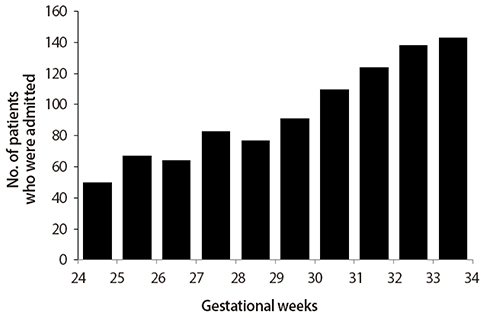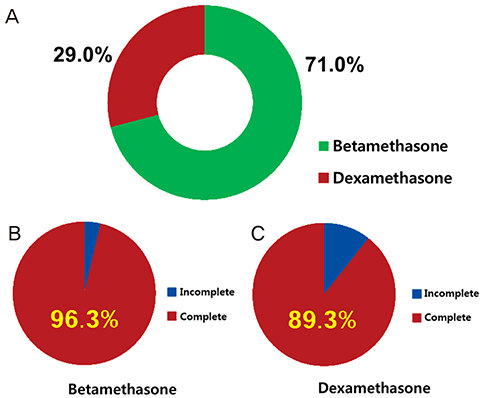Practice patterns in the management of threatened preterm labor in Korea: A multicenter retrospective study
- Affiliations
-
- 1Department of Obstetrics and Gynecology, Konkuk University Medical Center, Konkuk University School of Medicine, Seoul, Korea.
- 2Department of Obstetrics and Gynecology, Kangwon National University, School of Medicine, Chuncheon, Korea.
- 3Department of Obstetrics and Gynecology, Konyang University College of Medicine, Daejeon, Korea.
- 4Institute of Health & Science, Gyeongsang National University School of Medicine, Jinju, Korea.
- 5Department of Obstetrics and Gynecology, Kyung Hee University Medical Center, Kyung Hee University School of Medicine, Seoul, Korea.
- 6Department of Obstetrics and Gynecology, Korea University College of Medicine, Seoul, Korea.
- 7Department of Obstetrics and Gynecology, Eulji University College of Medicine, Daejeon, Korea.
- 8Department of Obstetrics and Gynecology, Seoul Metropolitan Government Seoul National University Boramae Medical Center, Seoul, Korea.
- 9Department of Obstetrics and Gynecology, Bucheon St. Mary's Hospital, The Catholic University of Korea College of Medicine, Bucheon, Korea.
- 10Department of Obstetrics and Gynecology, Seoul National University Bundang Hospital, Seoul National University College of Medicine, Seongnam, Korea.
- 11Departments of Obstetrics and Gynecology and Pediatrics, Samsung Medical Center, Sungkyunkwan University School of Medicine, Seoul, Korea.
- 12Department of Obstetrics and Gynecology, Seoul National University College of Medicine, Seoul, Korea.
- 13Department of Obstetrics and Gynecology, The Catholic University of Korea College of Medicine, Seoul, Korea.
- 14Department of Obstetrics and Gynecology, University of Ulsan College of Medicine, Asan Medical Center, Seoul, Korea.
- 15Department of Obstetrics and Gynecology, St. Vincent's Hospital, The Catholic University of Korea College of Medicine, Suwon, Korea.
- 16Department of Obstetrics and Gynecology, Soonchunhyang University College of Medicine, Seoul, Korea.
- 17Department of Obstetrics and Gynecology, Yonsei University Health System, Seoul, Korea.
- 18Department of Obstetrics and Gynecology, Yeouido St. Mary's Hospital, The Catholic University of Korea College of Medicine, Seoul, Korea.
- 19Department of Obstetrics and Gynecology, Chonnam National University Medical School, Gwangju, Korea.
- 20Department of Obstetrics and Gynecology, Cheil General Hospital and Women's Healthcare Center, Catholic Kwandong University College of Medicine, Seoul, Korea.
- 21Department of Obstetrics and Gynecology, Dankook University College of Medicine, Cheonan, Korea.
- 22Department of Obstetrics and Gynecology, Ewha Womans University School of Medicine, Seoul, Korea. kkyj@ewha.ac.kr
- KMID: 2148932
- DOI: http://doi.org/10.5468/ogs.2015.58.3.203
Abstract
OBJECTIVE
This study aimed to examine clinical practice patterns in the management of pregnant women admitted with threatened preterm labor (TPL) in Korea.
METHODS
Data from women admitted with a diagnosis of TPL were collected from 22 hospitals. TPL was defined as regular uterine contractions with or without other symptoms such as pelvic pressure, backache, increased vaginal discharge, menstrual-like cramps, bleeding/show and cervical changes. Data on general patient information, clinical characteristics at admission, use of tocolytics, antibiotics, and corticosteroids, and pregnancy outcomes were collected using an online data collections system.
RESULTS
A total of 947 women with TPL were enrolled. First-line tocolysis was administered to 822 (86.8%) patients. As a first-line tocolysis, beta-agonists were used most frequently (510/822, 62.0%), followed by magnesium sulfate (183/822, 22.3%), calcium channel blockers (91/822, 11.1%), and atosiban (38/822, 4.6%). Of the 822 women with first-line tocolysis, second-line tocolysis were required in 364 (44.3%). Of 364 with second-line, 199 had third-line tocolysis (37.4%). Antibiotics were administered to 29.9% of patients (284/947) with single (215, 22.7%), dual (26, 2.7%), and triple combinations (43, 4.5%). Corticosteroids were administered to 420 (44.4%) patients. Betamethasone was administered to 298 patients (71.0%), and dexamethasone was administered to 122 patients (29.0%).
CONCLUSION
Practice patterns in the management of TPL in Korea were quite various. It is needed to develop standardized practice guidelines for TPL management.
MeSH Terms
-
Adrenal Cortex Hormones
Anti-Bacterial Agents
Back Pain
Betamethasone
Calcium Channel Blockers
Dexamethasone
Diagnosis
Female
Humans
Korea
Magnesium Sulfate
Muscle Cramp
Obstetric Labor, Premature*
Physician's Practice Patterns
Pregnancy
Pregnancy Outcome
Pregnant Women
Premature Birth
Retrospective Studies*
Tocolysis
Tocolytic Agents
Uterine Contraction
Vaginal Discharge
Adrenal Cortex Hormones
Anti-Bacterial Agents
Betamethasone
Calcium Channel Blockers
Dexamethasone
Magnesium Sulfate
Tocolytic Agents
Figure
Cited by 3 articles
-
Differential expression and methylation of integrin subunit alpha 11 and thrombospondin in the amnion of preterm birth
Jae Young Yoo, Young-Ah You, Eun Jin Kwon, Mi Hye Park, Sunah Shim, Young Ju Kim
Obstet Gynecol Sci. 2018;61(5):565-574. doi: 10.5468/ogs.2018.61.5.565.Efficacy and side effect of ritodrine and magnesium sulfate in threatened preterm labor
Min Kyoung Kim, Seung Mi Lee, Jung Won Oh, So Yeon Kim, Hye Gyeong Jeong, Sun Min Kim, Chan Wook Park, Jong Kwan Jun, Seo-kyung Hahn, Joong Shin Park
Obstet Gynecol Sci. 2018;61(1):63-70. doi: 10.5468/ogs.2018.61.1.63.How much have the perinatal outcomes of triplet pregnancies improved over the last two decades?
Kyu-Sang Kyeong, Jae-Yoon Shim, Soo-young Oh, Hye-Sung Won, Pil Ryang Lee, Ahm Kim, Sung-Cheol Yun, Pureun-Narae Kang, Suk-Joo Choi, Cheong-Rae Roh
Obstet Gynecol Sci. 2019;62(4):224-232. doi: 10.5468/ogs.2019.62.4.224.
Reference
-
1. Meloni A, Melis M, Alba E, Deiana S, Atzei A, Paoletti AM, et al. Medical therapy in the management of preterm birth. J Matern Fetal Neonatal Med. 2009; 22:Suppl 3. 72–76.2. Haas DM, Imperiale TF, Kirkpatrick PR, Klein RW, Zollinger TW, Golichowski AM. Tocolytic therapy: a meta-analysis and decision analysis. Obstet Gynecol. 2009; 113:585–594.3. Han S, Crowther CA, Moore V. Magnesium maintenance therapy for preventing preterm birth after threatened preterm labour. Cochrane Database Syst Rev. 2013; 5:CD000940.4. Diguisto C, Le Ray C, Maillard F, Khoshnood B, Verspyck E, Perrotin F, et al. Individual and organisational determinants associated with maintenance tocolysis in the management of preterm labour: a multilevel analysis. PLoS One. 2012; 7:e50788.5. Goldenberg RL, Culhane JF, Iams JD, Romero R. Epidemiology and causes of preterm birth. Lancet. 2008; 371:75–84.6. Tucker JM, Goldenberg RL, Davis RO, Copper RL, Winkler CL, Hauth JC. Etiologies of preterm birth in an indigent population: is prevention a logical expectation. Obstet Gynecol. 1991; 77:343–347.7. Savitz DA, Blackmore CA, Thorp JM. Epidemiologic characteristics of preterm delivery: etiologic heterogeneity. Am J Obstet Gynecol. 1991; 164:467–471.8. Martin JA, Hamilton BE, Sutton PD, Ventura SJ, Mathews TJ, Osterman MJ. Births: final data for 2008. Natl Vital Stat Rep. 2010; 59:13–71.9. Romero R, Dey SK, Fisher SJ. Preterm labor: one syndrome, many causes. Science. 2014; 345:760–765.10. American College of Obstetricians and Gynecologists. Committee on Practice Bulletins-Obstetrics. ACOG practice bulletin no. 127: management of preterm labor. Obstet Gynecol. 2012; 119:1308–1317.11. DeFranco EA, Lewis DF, Odibo AO. Improving the screening accuracy for preterm labor: is the combination of fetal fibronectin and cervical length in symptomatic patients a useful predictor of preterm birth? A systematic review. Am J Obstet Gynecol. 2013; 208:233.e1–233.e6.12. Katz M, Goodyear K, Creasy RK. Early signs and symptoms of preterm labor. Am J Obstet Gynecol. 1990; 162:1150–1153.13. Copper RL, Goldenberg RL, Davis RO, Cutter GR, DuBard MB, Corliss DK, et al. Warning symptoms, uterine contractions, and cervical examination findings in women at risk of preterm delivery. Am J Obstet Gynecol. 1990; 162:748–754.14. Brownfoot FC, Gagliardi DI, Bain E, Middleton P, Crowther CA. Different corticosteroids and regimens for accelerating fetal lung maturation for women at risk of preterm birth. Cochrane Database Syst Rev. 2013; 8:CD006764.15. Hiersch L, Yogev Y, Domniz N, Meizner I, Bardin R, Melamed N. The role of cervical length in women with threatened preterm labor: is it a valid predictor at any gestational age. Am J Obstet Gynecol. 2014; 211:532.e1–532.e9.16. Keskin U, Ulubay M, Kurt YG, Fidan U, Kocyigit YK, Honca T, et al. Increased neopterin level and chitotriosidase activity in pregnant women with threatened preterm labor. J Matern Fetal Neonatal Med. 2014; 28:1–5.17. Heng YJ, Pennell CE, Chua HN, Perkins JE, Lye SJ. Whole blood gene expression profile associated with spontaneous preterm birth in women with threatened preterm labor. PLoS One. 2014; 9:e96901.18. Van Vliet EO, Boormans EM, de Lange TS, Mol BW, Oudijk MA. Preterm labor: current pharmacotherapy options for tocolysis. Expert Opin Pharmacother. 2014; 15:787–797.19. Flenady V, Hawley G, Stock OM, Kenyon S, Badawi N. Prophylactic antibiotics for inhibiting preterm labour with intact membranes. Cochrane Database Syst Rev. 2013; 12:CD000246.
- Full Text Links
- Actions
-
Cited
- CITED
-
- Close
- Share
- Similar articles
-
- Does a preterm labor-assessment algorithm improve preterm labor-related knowledge, clinical practice confidence, and educational satisfaction?: a quasi-experimental study
- Recent Trends in Management of Preterm Labor
- Overview for the management of preterm labor
- Use of progesterone as a preventive medicine and nifedipine as a treatment of preterm labor
- Comparison of pregnancy prognosis by surgical management for Adnexal mass in pregnancy



